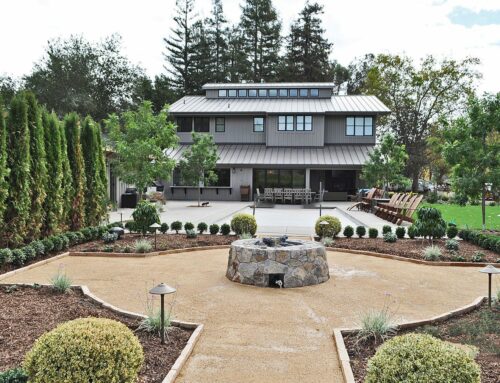In the wake of the recent devastating wildfires in Northern California, homeowners are reminded of the importance of fire safety precautions. Many are taking extra steps to maintain fire safe landscaping. As a leading home building company in Northern California, our team at Annadel Builders, Inc. knows how essential fire safety is for the California homeowner. While it’s impossible to ensure 100% safety against wildfires, there are practical steps you can take to minimize your risk. Make sure to implement these fire safety suggestions in your Northern California home before you’re threatened by a wildfire.
- Create a home defense zone – A fire safe landscape must include two zones: A home defense zone and a reduced fuel zone. A home defense zone requires removing and clearing all flammable vegetation and other combustible growth within 30 feet of the house. Exceptions to this rule include single specimens of trees, shrubs, or other vegetation that are well pruned and sufficiently spaced from one another.
- Create a reduced fuel zone – A reduced fuel zone is an area surrounding the home with a radius of at least 70 feet. Within this zone, all trees and brush should be thinned out. For landscapes that include less than a 20% slope, there should be at least 10 feet between the tips of tree limbs, and at least 20 feet between trees growing on slopes that are 20-40%. For slopes over 40%, extend the distance to 30 feet. For shrubs, try to only plant varieties that are low growing, widely separated, deciduous, and non-resinous. Spacing for shrubs should be 2 times the shrub’s height on a 0-20% slope, 4 times for a 20-40% slope, and 6 times for slopes over 40%.
- Perform annual maintenance – Over time, as plants grow, mulch dries out and leaves and needles begin to accumulate. That’s when maintenance becomes a critical aspect of fire prevention and safety. Here are a few key principles to keep in mind as you plan your yard maintenance:
- Keep plants green, using irrigation if needed.
- Mow grass during the green season to avoid a potential spark fire that could be caused by mowing in dry grass.
- Clean all needles and leaves from your roof, eaves, and rain gutters.
- Clean vegetation and flammable materials from beneath your deck.
- Check and prune trees and shrubs annually to maintain the proper distance between plants.
- Vegetation arrangement – Most wildfires begin as surface fires, meaning they usually need horizontal fuel continuity to spread across the landscape. To break fuel continuity and prevent surface-level spread, homeowners can widen the spacing between the plants close to their homes. In addition, to prevent vertical fuel continuity—also known as “ladder” fuels—remove lower tree limbs that are 15 feet or less above the ground.
- Use noncombustible landscape materials – Use masonry, gravel, or stone walls in your landscaping. Not only will this improve the fire resistance of your yard, but it will also provide variety and texture. Consider further breaking up fuel continuity with decorative rock, gravel, and stepping stone pathways.
- Plant fire resistant vegetation – While it’s important to remember that all plants are flammable given the right conditions, certain plants can greatly decrease the likelihood of a fire spreading. Look for plants that have high moisture content in their leaves, little to no seasonal accumulation of dead vegetation, open branching, and are non-resinous and slow growing. Examples of potentially fire resistant plants include: Sage, California Fuchsia, yellow ice plants, and French lavender. Fire-resistant trees include: Maple, poplar, and cherry.
Please note that the steps and specific distances noted above are only practical suggestions and should NOT be taken as our official professional recommendation. Always consult with an expert for fire safety advice tailored to your home and landscape.



